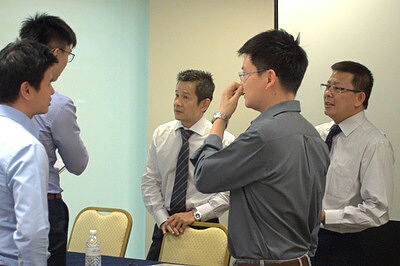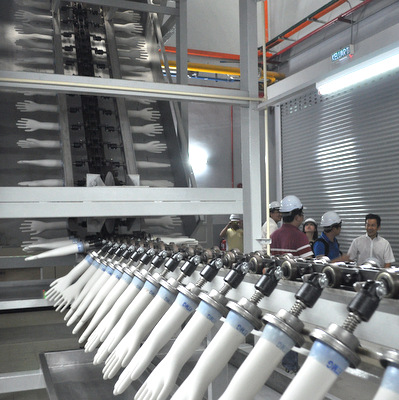Page 2 of 2
4. Cleanroom gloves: Riverstone produces premium grade gloves for use in cleanrooms. It has introduced new lines of gloves (branded as Cleancare and A Clean) which are priced slightly lower so as to defend the 'RS' premium brand image.
Reflecting its strong hold on the high-end cleanroom glove sector, Riverstone enjoyed about 12% growth in volume last year, and expects double-digit growth again this year.
The growth drivers are the mobile phone and tablet sectors while the hard disk drive sector is flattish.
 Executive chairman and CEO Wong Teek Son (center, in white shirt) and CFO Lim Sing Poew (far right, in white shirt) speak with attendees after the results briefing. Photo by Leong Chan TeikRiverstone "is a significant leader in ESD (electrostatic discharge) technology and we have teams that work with the customers to customise cleanroom gloves."
Executive chairman and CEO Wong Teek Son (center, in white shirt) and CFO Lim Sing Poew (far right, in white shirt) speak with attendees after the results briefing. Photo by Leong Chan TeikRiverstone "is a significant leader in ESD (electrostatic discharge) technology and we have teams that work with the customers to customise cleanroom gloves."Another barrier to entry for competitors is the fact that the audit process for potential suppliers is relatively more stringent than for healthcare gloves.
"So far, none of our customers have gone to our competitors, and we are in fact getting new orders," said Mr Wong Teek Son, chairman and CEO of Riverstone.
"Through our marketing studies, we found that there's a big gap between our competitors and us."
Riverstone reckons that for high-end cleanroom gloves (Class 100 and Class 10), it has a market share of about 60%.
It ships its gloves directly to customers, mostly in Asia-Pacific, unlike for healthcare gloves where it deals with distributors all over the world who on-sell to customers such as hospitals.
5. Revenue/volume split: In terms of revenue, cleanroom and healthcare gloves had a 50-50 split. In terms of volume, it was 30-70, reflecting the higher selling prices of cleanroom gloves.
 @ Riverstone's new plant in Taiping, adjacent to which Riverstone is building another 1-billion capacity plant.
@ Riverstone's new plant in Taiping, adjacent to which Riverstone is building another 1-billion capacity plant. NextInsight file photo.These proportions are expected to stay constant for this year.
6. Utilisation rate: All of Riverstone's production lines are taken up, running 24/7.
But because of the time needed to prepare production lines to change over to produce products according to various customers' requirements (in terms of the weight and other properties of the gloves), the actual factory utilistion rate is about 90%.
"Even if customers come to us with more orders, we cannot accept them. That's why we have to speed up the second phase of our current factory expansion," said Mr Wong.





